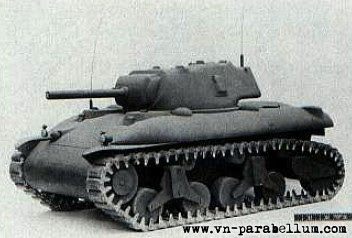T7E5
The M7 had significantly less armor than the M4 Sherman, boasted no greater firepower, and held only a slight advantage in top speed. For these reasons, and because the M4 was already battle-tested and in full production, the M7 was put aside shortly after completing trials.
| Medium Tank M7 | |
|---|---|

Third production M7 medium tank at the General Motors Proving Ground.
| |
| Type | Medium tank |
| Place of origin | United States |
| Production history | |
| Manufacturer | International Harvester Corp. |
| Produced | 1942 |
| Number built | 7 |
| Specifications | |
| Weight | 53,950 lb (24,470 kg) |
| Length | 17 ft 2 in (5.23 m) |
| Width | 9 ft 4 in (2.84 m) |
| Height | 7 ft 9 in (2.36 m) |
| Crew | 5 (Commander, loader, gunner, driver, co-driver) |
| Armor | 13–64 mm (0.51–2.52 in) |
Main
armament | 75 mm M3 in M47 mount 71 rounds |
Secondary
armament | 3 × .30-06 Browning M1919A4 MG 4,500 rounds |
| Engine | Continental R975 C1; 9 cylinder, 4 cycle, radial gasoline 350 hp (260 kW ) |
| Suspension | Vertical volute spring |
| Speed | 30 mph (48 km/h) on road |
Classifications
T7 - Welded hull, five speed Hydramatic transmission, volute spring suspension
T7E1 - Riveted hull, formed homogenous plate turret, torque converter.
T7E2 -
Cast upper hull, Wright R-975 Engine, Warner Gear torque converter, armed with Ordnance QF 6-pounder Mark III.
T7E3 - Welded hull and turret, twin Hercules DRXBS diesel engines, Detroit Gear automatic transmission.
T7E4 -
Welded hull and turret, twin Cadillac engines, two Hydramatic transmissions
--
T7E5 - T7E2 rearmed with 75 mm M3 standardized as M7 medium.
Test revealed that the produced vehicles were heavier than anticipated at 28 to 29 tons fully stowed. This reduced performance and production was halted until it could be rectified. Analysis of the problem indicated that it was caused by castings being thicker than specified. Six of the production tanks were then modified to use the lightest castings possible and their power trains were revised to improve performance.
The modified vehicles were referred to as M7E2s in some documents. Testing of the modified vehicles revealed improved performance but only at lower speeds and that the performance was considered inferior to the M4A3 medium tank. The 6 modified vehicles and the remaining 7 were accepted as M7 mediums bringing the total run to 13 tanks. Thus production acceptance records show only a total of 7 tanks.



Not a very good tank compared to the Soviet and German models
VastaaPoistaMoi S-K
PoistaTrue.
We must to remember that, all the US tanks were are compromises, their structure.
The first "real" US tank had M-24 Chaffee, which is realy pretty and good size, first model without users problems.
US tank production started after the French was surrender.
VastaaPoistaCompromise solutions tank were all functional, but not very good.
Light M3 and M5 and last sherman models were the best.